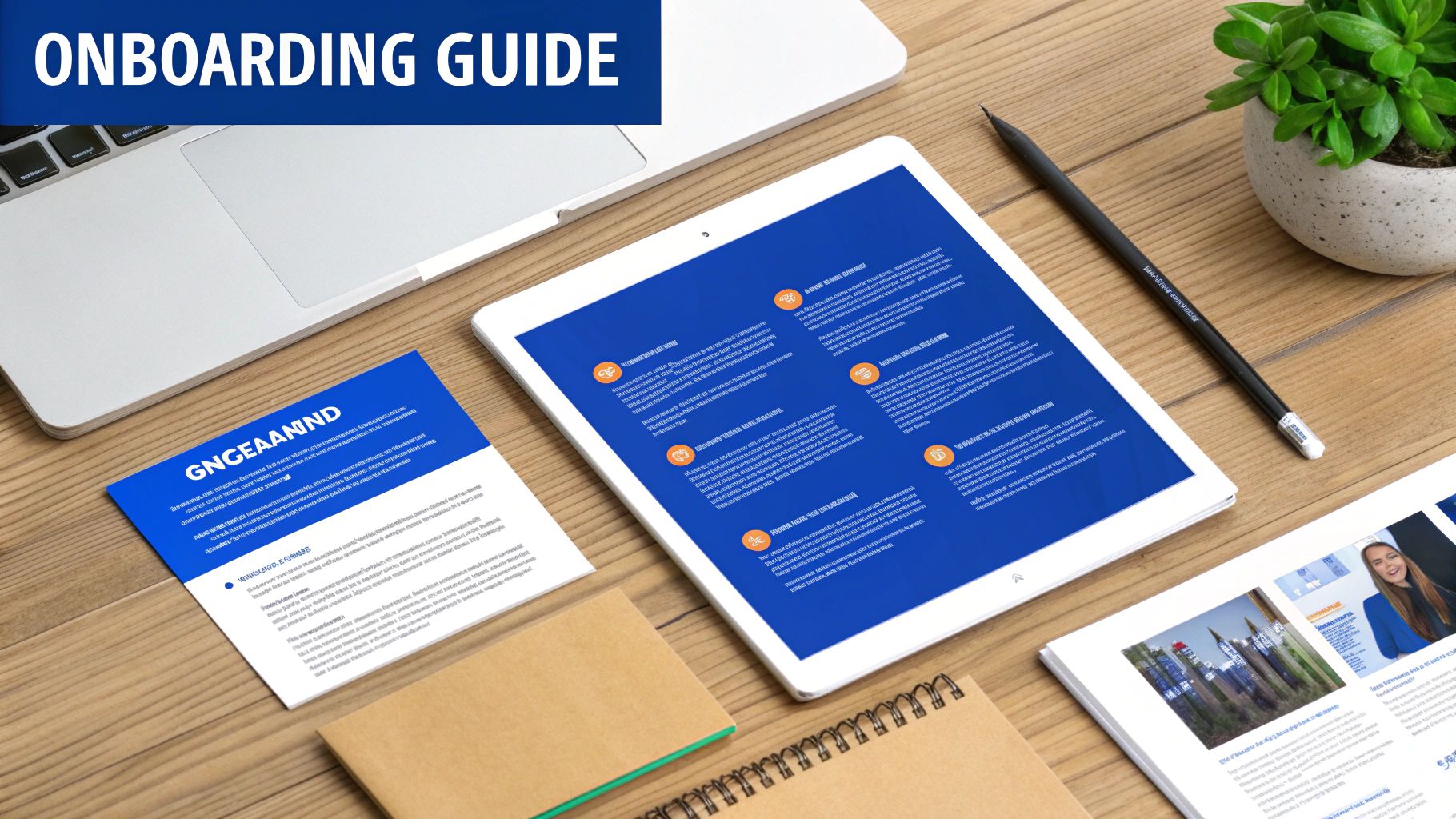Why Customer Onboarding Makes or Breaks Business Success

First impressions matter. This is especially true when welcoming new customers to your business. These initial interactions shape the entire customer relationship. They’re not just procedural steps; they’re the foundation of long-term success. This makes a strong onboarding process essential for any business.
The Psychology of First Impressions
Think about meeting someone for the first time. Your initial impression influences all future interactions. The same is true for customers interacting with your business. A positive onboarding experience builds trust and confidence. A negative one can cause frustration and ultimately, customer churn.
Onboarding and Business Performance
Businesses that prioritize customer onboarding see better results than those that don’t. This improved performance shows up in key metrics. Effective onboarding leads to increased customer lifetime value, lower support costs, and better customer retention. Plus, satisfied customers become brand advocates, leading to organic growth through referrals.
Customer onboarding significantly impacts customer retention and acquisition. In fact, 63% of customers consider the onboarding experience when deciding whether to buy a product or subscribe to a service. This shows that onboarding isn’t just a formality; it’s a crucial factor in customer commitment. Companies that neglect onboarding risk losing potential long-term customers from the start. A good onboarding experience, from day one, is essential to building trust and confidence. For more statistics, check out this resource: Learn more about customer onboarding statistics. You can also find helpful tips here: Executive Onboarding Best Practices.
The Hidden Costs of Poor Onboarding
Effective onboarding has clear benefits. But poor onboarding often has hidden costs that go beyond immediate lost revenue. A negative onboarding experience can hurt your brand’s reputation and make acquiring new customers more difficult. It can also lead to more support tickets and higher churn, impacting your bottom line. Investing in a strategic approach to onboarding is key.
Examples of Onboarding Success
Many businesses have improved their growth by focusing on their onboarding process. Some have introduced personalized welcome videos, interactive tutorials, and dedicated onboarding specialists. These initiatives create a more engaging and supportive experience for new customers, resulting in increased satisfaction and retention. These businesses understand that effective customer onboarding is an investment, not an expense.
Crafting Your Customer-Centric Onboarding Framework

Generic welcome emails are outdated. Today’s effective onboarding requires a well-planned, strategic framework. This framework must balance business needs with a genuine focus on customer satisfaction. It means going beyond simple checklists and creating a truly resonant experience for every new user.
Mapping the Customer Journey
Understanding the customer journey is the first crucial step in building your onboarding framework. This means identifying every interaction a customer has with your business, from initial discovery all the way to long-term engagement. By understanding this journey, you can identify the critical moments of truth where onboarding matters most. These key interactions significantly impact a customer’s perception of your product and their likelihood of sticking around.
Designing for Confidence and Momentum
Every onboarding interaction should build customer confidence and create forward momentum. A well-designed tutorial, for example, can empower users to quickly understand core features. Acknowledging early successes also reinforces positive feelings and encourages continued use. Something as simple as a congratulatory message within the app when a user completes a key task can create a sense of accomplishment, motivating further exploration and deeper engagement.
Personalization Without Operational Nightmares
Personalization is essential for effective onboarding. However, finding the right balance between personalized experiences and streamlined operations is key. Segmenting your customers based on their needs and how they use your product lets you tailor the onboarding journey without creating unsustainable processes. For example, a small business owner onboarding a new client will have different needs than a large corporation. Tailoring the experience to these distinct segments is vital.
The following table summarizes the key components of a customer onboarding framework, their purpose, implementation considerations, and their impact on the customer experience.
Customer Onboarding Framework Components
| Component | Purpose | Implementation Considerations | Customer Impact |
|---|---|---|---|
| Customer Journey Mapping | Understand customer interactions with your business | Identify all touchpoints, from initial awareness to long-term engagement. | Increased customer understanding and improved targeting of onboarding efforts. |
| Confidence-Building Design | Empower users and encourage continued engagement | Implement tutorials, highlight early successes, and provide positive reinforcement. | Improved product adoption, reduced churn, and increased customer satisfaction. |
| Personalized Onboarding | Tailor the onboarding experience to individual customer needs | Segment customers based on needs and use cases. Create targeted onboarding flows for different segments. | Increased engagement and a more relevant customer experience. |
| Flexible Learning Paths | Accommodate different learning styles and customer preferences | Offer multiple onboarding options, including self-guided tutorials, hands-on support, and on-demand resources. | Improved accessibility and caters to a wider range of customer learning preferences. |
| Success Criteria Definition | Measure the effectiveness of the onboarding process and identify areas for improvement | Track metrics such as Time to Value (TTV), feature adoption rates, and customer satisfaction. Regularly review and adjust the onboarding framework based on data. | Data-driven optimization of the onboarding process, leading to better business outcomes and improved customer satisfaction. |
As the table highlights, a robust onboarding framework considers the entire customer journey, from initial contact to ongoing engagement.
The Importance of Flexibility
While structure is important, flexibility is also crucial. Customers learn in different ways. Some prefer self-guided tutorials, while others thrive with more direct support. Your onboarding framework should accommodate these varied needs by offering multiple learning paths, readily available resources, and easy access to your support team.
Defining Meaningful Success Criteria
Finally, defining clear success metrics for your onboarding process is critical. These metrics should align with both customer goals and your business objectives. Track metrics like Time to Value (TTV), feature adoption rates, and customer satisfaction. By measuring these outcomes, you can pinpoint areas for improvement and continually fine-tune your framework. This iterative process ensures your onboarding remains effective and delivers value for both your customers and your business. SaaS onboarding statistics often reveal the impact of a well-designed process. For example, 55% of customers might abandon a product they don’t understand, and 75% could leave within the first week if they encounter difficulties. Onboarding corporate clients can take an average of 100 days. Ultimately, 89% of customers might switch to competitors after a negative experience. The impact on customer lifetime value and revenue is significant.
The Dollars and Sense of Exceptional Onboarding

Onboarding a customer is more than just a friendly welcome; it’s a vital driver of revenue and long-term success. This section explores the significant financial impact of a well-executed onboarding process. We’ll see how even small improvements in key metrics can dramatically affect your bottom line.
The Impact on Customer Lifetime Value
Effective onboarding significantly boosts Customer Lifetime Value (CLTV). When customers quickly grasp the value of your product or service, they’re more likely to stay engaged. This increased engagement translates into higher revenue per customer. Satisfied customers are also more likely to upgrade their plans or buy additional services, further increasing CLTV.
Reducing Support Costs Through Effective Onboarding
A robust onboarding process can dramatically reduce support costs. By providing clear guidance, comprehensive documentation, and accessible resources, you empower customers to self-serve. This reduces support tickets and frees up your team to handle complex issues. For instance, video tutorials within Superdocu on creating custom request links can preemptively answer common questions.
The Ripple Effect: Word-of-Mouth Acquisition
Exceptional onboarding fosters customer loyalty and advocacy. A positive initial experience encourages customers to recommend your product or service. This organic word-of-mouth marketing is invaluable, generating new customers without significant marketing spend. Positive reviews and testimonials also build brand credibility.
Building the Business Case for Onboarding Investments
Investing in onboarding requires a clear understanding of the return on investment (ROI). By calculating the potential increase in CLTV, the reduction in support costs, and the impact on customer acquisition, you build a compelling business case for onboarding initiatives. This data-driven approach justifies allocating resources to improve the process. Track metrics like time to first value, feature adoption rates, and customer churn to demonstrate the financial impact of onboarding.
Globally, neglecting effective onboarding leads to significant losses. In the UK and US alone, over $37 billion is lost annually due to unproductive employees, often linked to inefficient onboarding. Over 90% of customers believe companies could improve their onboarding, and 43% of small to medium-sized businesses report losing clients due to poor onboarding. Explore this topic further for more detailed statistics. This highlights the urgent need for optimized onboarding.
Prioritizing Initiatives for Maximum Impact
Not all onboarding initiatives are equally effective. By analyzing data and understanding customer needs, you can prioritize initiatives with the greatest financial impact. For example, if data reveals customers struggle with a particular feature, improving documentation for that feature would likely yield a higher ROI. Focus on areas that significantly impact customer satisfaction. This might involve personalizing the onboarding experience in Superdocu, such as offering tailored templates for legal firms versus real estate agencies. This targeted approach ensures resources are used efficiently.
Choosing Technology That Transforms the Onboarding Journey

The right technology can significantly improve the customer onboarding journey, turning it into a truly positive experience. However, the sheer number of available options can feel overwhelming. This section explores how to choose the right tools to build a personalized and efficient onboarding process.
Balancing Automation and Human Touchpoints
Successful onboarding blends automation with personal interaction. Automating repetitive tasks frees up your team to build relationships and provide personalized support.
For example, automated emails through Superdocu can handle document reminders. This allows your team to focus on answering client-specific questions and offering a more tailored onboarding experience. This combination creates a process that is both efficient and personal.
Evaluating Technology Options
Choosing the right technology hinges on your specific needs. Consider your customer base, their preferred learning styles, and the complexity of your product or service.
Think about integration requirements, too. Does the technology integrate seamlessly with your existing CRM or marketing automation platform? Scalability is also crucial. Can the technology grow alongside your business? Superdocu, with its tiered pricing and integrations with tools like Zapier and DocuSign, provides this flexibility.
Avoiding Implementation Pitfalls
Technology implementation requires careful planning. Common pitfalls include inadequate training, poor communication, and unclear goals.
To avoid these, start with a pilot program. Testing with a small group helps identify potential problems before a full-scale launch. Regularly collect feedback from your team and your customers to confirm the technology meets everyone’s needs.
Measuring Technology ROI
Measuring the return on investment (ROI) for onboarding technology is essential. Track key metrics such as time to first value, customer satisfaction, and support ticket volume. Compare these metrics before and after implementation to gauge its impact. If, for instance, Superdocu reduces document collection time, this translates into cost savings and higher customer satisfaction. These benefits demonstrate the value of the investment.
Industry-Specific Solutions
Different industries face unique onboarding challenges. A legal firm onboarding a client has different needs than a retail store welcoming a shopper. Some industries benefit from specialized onboarding platforms. Others may find general solutions sufficient. Superdocu offers templates for legal, real estate, HR, and other sectors, making it highly adaptable. This allows businesses to quickly create customized onboarding flows.
The following table provides a comparison of different customer onboarding technology solutions. It highlights their key features, benefits, limitations, and ideal use cases, along with their pricing models. This will help you choose the right technology for your business needs.
Onboarding Technology Comparison
| Technology Type | Key Features | Best For | Limitations | Pricing Model |
|---|---|---|---|---|
| Generic Onboarding Software (e.g., Superdocu) | Automated workflows, document management, e-signatures, customizable templates | Businesses of all sizes and industries | Can be less specialized for niche industries | Tiered pricing based on features and usage |
| Industry-Specific Onboarding Platforms (e.g., for Healthcare or Finance) | Compliance features, industry-specific templates and workflows, integrated reporting | Businesses in regulated or highly specialized industries | Less flexible for diverse business needs | Often subscription-based, with pricing based on user count or features |
| CRM with Onboarding Functionality (e.g., Salesforce) | Integrated with sales and marketing tools, automated lead nurturing, opportunity management | Sales-driven organizations focused on lead conversion | Can lack specialized onboarding features | Subscription-based, typically based on user count and features |
| Project Management Software with Onboarding Adaptations (e.g., Asana) | Task management, team collaboration, progress tracking | Smaller businesses or teams with simple onboarding processes | Limited automation and customization options | Tiered pricing based on user count and features |
This comparison shows the diverse range of onboarding technology available. Choosing the best solution requires careful consideration of your industry, business size, and specific onboarding needs.
Building a Flexible Tech Ecosystem
Your technology needs will change as your business expands. Choose solutions that are flexible and adaptable. Avoid being locked into a rigid system. A modular approach allows you to adjust technology components as needed. This keeps your onboarding process effective and efficient, creating a robust and scalable ecosystem that supports your customer onboarding journey now and into the future.
Scaling Personal Touches in Your Onboarding Experience
Onboarding new customers effectively is crucial for any business. But how do you maintain a personal touch when dealing with a large volume of new users? This section explores how to create personalized experiences at scale without overspending or overwhelming your team. It’s all about making every customer feel valued, even within a streamlined onboarding process.
Segmentation Beyond Demographics
Truly effective personalization starts with understanding your customers. Go beyond basic demographics. Segment your customers based on factors like their use cases, technical skills, and business objectives. For instance, a small business owner using Superdocu to manage contracts will have different needs than a large corporation using it for employee onboarding. This nuanced approach allows for a more tailored and relevant onboarding experience.
Customization vs. Standardization: Finding the Right Balance
It’s important to remember that not every aspect of onboarding needs to be personalized. Identify the key elements that truly benefit from a personal touch. Consider personalizing welcome messages, initial training resources, and follow-up communications. Standardize elements like core feature tutorials and general help documents. This strategic balance provides individual attention while maintaining efficiency and optimizing resource allocation.
Dynamic Onboarding with Behavioral Triggers and Progressive Profiling
Behavioral triggers and progressive profiling allow for dynamic, customized onboarding experiences. For example, if a Superdocu user consistently utilizes a specific feature, trigger in-app messages showcasing advanced functionalities related to that feature. Gather more data about customer needs throughout onboarding, using this data to further refine and personalize the experience. Choosing the right technology can be a challenge; an AI model comparison for 2025 can be useful. This creates an adaptive onboarding process personalized to each customer’s journey.
Gathering Meaningful Feedback Throughout the Onboarding Process
Actively seek feedback throughout the onboarding process. Use in-app surveys, feedback forms, and personalized check-in emails. Ask specific questions about the customer’s experience and identify any difficulties. This feedback is invaluable for improving and refining your onboarding process over time.
Implementing Personalization That Feels Genuine
Automated personalization can sometimes feel impersonal. Introduce genuine human interaction at critical points. A personalized email from a support specialist can make a real difference. A handwritten welcome note with a company gift can also build rapport and create a personal connection. This blend of automated efficiency and genuine human interaction makes for a memorable onboarding experience.
Practical Approaches for Scalable Personalization
Here are some practical tips for providing personalized onboarding experiences at scale:
- Utilize templates: Superdocu offers pre-built templates for various industries, allowing you to quickly create custom onboarding flows.
- Automate where possible: Use Superdocu’s automation to send targeted emails and reminders based on customer segments and behaviors.
- Leverage data: Analyze customer data in Superdocu to understand usage patterns and identify areas for improvement.
- Offer self-service resources: Provide detailed help documentation, FAQs, and video tutorials.
- Provide proactive support: Anticipate potential challenges and offer timely support through Superdocu if a user struggles with a specific feature.
By implementing these strategies, you can create a scalable, personalized onboarding experience that fosters customer engagement and loyalty.
Measuring What Matters in Your Onboarding Process
After implementing your onboarding framework and choosing the right technology, the next critical step is measuring its effectiveness. This involves going beyond superficial metrics and focusing on the data that truly reflects onboarding success. This section will help you identify the key performance indicators (KPIs) that matter most at each stage of the customer journey and how to use this data to continually improve your onboarding process.
Key Onboarding Metrics and Their Significance
Identifying the right metrics is crucial for understanding how well your onboarding is performing. These metrics should align with your overall business goals and reflect the customer journey within your product.
Here are some key indicators to consider:
Time to First Value (TTFV): This measures how long it takes a new customer to experience the core value of your product or service. A shorter TTFV generally leads to higher customer satisfaction and retention. For Superdocu users, this might be the time it takes to successfully collect their first set of documents.
Feature Adoption Rate: This tracks how quickly and thoroughly customers are using key features. High adoption rates suggest a good understanding of the product and increased customer engagement. If Superdocu users aren’t utilizing automated reminders, it could indicate a need for better training or in-app guidance.
Support Ticket Volume: A high volume of support tickets from new users can signal problems with the onboarding process. Analyzing the reasons behind these tickets can pinpoint areas for improvement. Are Superdocu users frequently contacting support about setting up custom request links? Perhaps a video tutorial within the app could help.
Customer Satisfaction (CSAT) Score: This measures how satisfied customers are with the onboarding experience. Regularly surveying new users can provide valuable feedback. A drop in CSAT scores might indicate friction points that need addressing within the Superdocu onboarding flow.
Customer Churn Rate: This indicates the percentage of customers who cancel their subscription or stop using your product or service within a specific timeframe. High churn rates, particularly during the initial stages after onboarding, could signify problems with the onboarding experience itself.
Implementing Tracking Systems for Actionable Intelligence
Collecting data requires robust tracking systems. Integrate your chosen onboarding technology, like Superdocu, with analytics platforms. This provides a holistic view of the customer journey. However, avoid data overload. Focus on tracking the KPIs that directly impact your business objectives.
For Superdocu, this could involve tracking how quickly clients complete document requests, which features they use most, and how often they access the help documentation. This data provides actionable insights, rather than overwhelming you with unnecessary information.
Combining Quantitative and Qualitative Feedback
While quantitative data is essential, qualitative feedback adds depth and context. Surveys are a powerful tool for gathering qualitative data. Ask open-ended questions to encourage detailed responses about the customer’s experience.
For example, Superdocu could include a survey at the end of the onboarding process asking users to describe their experience and suggest improvements. This qualitative data, combined with quantitative metrics, paints a more complete picture of onboarding effectiveness.
Translating Insights into Continuous Improvement
Data analysis is only valuable if it leads to action. Regularly review your onboarding metrics and identify areas for improvement. A decrease in TTFV, for instance, might be achieved by streamlining the initial setup process in Superdocu. A low feature adoption rate could signal a need for more targeted in-app tutorials.
Use A/B testing to experiment with different onboarding approaches. This helps optimize the process based on real user behavior. For Superdocu, test different versions of welcome emails or in-app messages to determine which resonates best with new users.
By continuously measuring, analyzing, and refining, you ensure that your onboarding process is efficient, effective, and drives positive outcomes for both your customers and your business.
Building Your Dream Onboarding Team
The success of your customer onboarding process depends heavily on the people involved. This section explores the critical roles, necessary skills, and team structures needed to create truly exceptional onboarding experiences. We’ll discuss how responsibilities are distributed within your organization, where key handoffs happen, and how to maintain accountability throughout the customer journey.
Essential Roles in an Onboarding Team
Several key roles contribute to a successful onboarding team. Let’s take a closer look:
Onboarding Specialist: This is the main point of contact for new customers, guiding them through the initial stages of product adoption. This role requires strong product knowledge, excellent communication skills, and a good dose of empathy. Imagine an onboarding specialist at Superdocu expertly guiding a new legal client through setting up custom request links for different case types.
Product Expert: The product expert provides in-depth product knowledge and troubleshooting assistance. This role makes sure the onboarding specialist has the resources to answer complex customer questions. For instance, the product expert might train the specialist on the details of Superdocu’s integration with DocuSign for e-signatures.
Customer Success Manager (CSM): The CSM takes over after the initial onboarding phase, focusing on long-term customer success and retention. This role ensures a smooth transition from onboarding to ongoing support. The CSM at Superdocu might check in with the client after a month to discuss how they’re using the platform and offer advanced tips.
Training and Development Lead: This role focuses on creating and delivering effective training programs for the onboarding team. This ensures the team stays up-to-date on product updates and best practices. They might create training materials on new Superdocu features or best practices for different industry verticals.
Key Skills for Onboarding Success
Beyond specific roles, certain skills are crucial for effective customer onboarding:
Product Knowledge: A deep understanding of your product or service is absolutely essential. This allows the team to confidently address customer questions and provide relevant guidance.
Communication Skills: Clear and concise communication helps build trust and rapport with new customers. This makes sure they understand the value of your product and how to use it effectively.
Empathy and Patience: New customers often need additional support and understanding. Team members who can empathize with their challenges and patiently guide them through the process are incredibly valuable.
Problem-Solving Abilities: Onboarding often involves troubleshooting technical issues and addressing customer concerns. Solid problem-solving skills enable the team to find solutions quickly and efficiently.
Structuring Your Onboarding Team for Scale
As your customer base grows, your team structure needs to adapt. Initially, a small, cross-functional team might handle all onboarding responsibilities. As you scale, specialization becomes more important. Consider creating dedicated teams for different customer segments or product lines. Superdocu, for example, might have separate teams specializing in onboarding legal clients versus real estate clients. This targeted approach allows for more personalized support.
Fostering Collaboration and Accountability
Clear communication and defined roles are essential for effective collaboration. Establish clear handoff procedures between onboarding specialists and customer success managers. This creates a smooth transition and minimizes confusion for the customer. Regular team meetings and feedback sessions help facilitate knowledge sharing and identify areas for improvement. Using a platform like Superdocu to track onboarding progress and document customer interactions promotes transparency and accountability across the team.
Building a Customer-Centric Culture
Building a culture that prioritizes customer success starts from the very beginning. Invest in training and development programs that emphasize customer empathy and product knowledge. Encourage feedback and open communication between the onboarding team and other departments. Celebrate onboarding successes and recognize team members who go the extra mile for customers. This fosters a positive and supportive environment, resulting in exceptional customer experiences. Ready to improve your document workflow and create a seamless onboarding experience for your clients? Explore Superdocu today! Learn more about Superdocu
